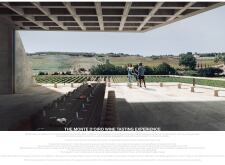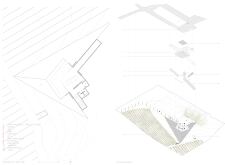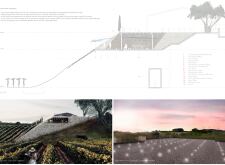5 key facts about this project
The Monte D’Oiro Wine Tasting Experience is an architectural project located in a prominent vineyard area. The design focuses on enhancing the wine tasting experience while integrating harmoniously with the landscape. The facility comprises a wine tasting room that is strategically positioned to maximize views of the surrounding grapevines, thereby reinforcing the connection between visitors and the winemaking process. This facility serves not only as a tasting venue but as an educational space where guests can engage with the viticultural aspects of the site.
The architecture of the project emphasizes the importance of environmental alignment, utilizing the natural contours of the site. The wine tasting room is strategically situated 4 meters below the arrival point, providing a sense of arrival that is both immersive and inviting. The descending pathway leads guests into a cooler, shaded environment that contrasts with the open air above. This design choice highlights the adaptability of the structure to its climatic conditions and enhances visitor comfort.
The belvedere terrace is a key feature that distinguishes this project from similar facilities. This cantilevered structure not only provides outdoor tasting opportunities but also frames unobstructed views of the vineyards. This visual connection fosters a deeper appreciation for the landscape, inviting guests to engage with the local terroir in a more meaningful way. The interplay of indoor and outdoor spaces is facilitated through large sliding glass doors, which can be opened to create a seamless transition between environments.
The materiality of the project is characterized by a careful selection of sustainable materials that complement the aesthetic of the site. Dry stacked stone is utilized for the retaining walls, providing stability and integrating the building’s lower levels with the landscape. Cork cladding inside the facility enhances acoustic comfort and temperature regulation, while concrete serves as the primary material for structural elements such as the waffle slab roof. The use of wood flooring adds warmth to the interior, aligning with the natural environment.
A notable design feature is the integration of natural ventilation strategies that optimize airflow within the building, thereby reducing reliance on mechanical systems. This approach underlines the design's commitment to sustainability and energy efficiency. Additionally, the planting of native vegetation around the site ensures that the development does not disrupt the local ecosystem, further reinforcing the project's ecological values.
In essence, the Monte D’Oiro Wine Tasting Experience represents an architectural response to its environment, fostering a bond between visitors and the vineyard. The careful consideration of the site’s topography, alongside the innovative use of materials and sustainable strategies, distinguishes this project within the context of wine tourism architecture.
For those interested in further exploring the innovative aspects of this architectural design, including detailed architectural plans, sections, and ideas, visiting the project presentation will provide valuable insights into its conceptual development and execution.


























